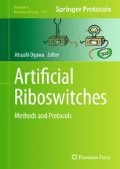Abstract
Riboswitches have a number of characteristics that make them ideal regulatory elements for a wide range of synthetic biology applications. To maximize their utility, methods are required to create custom riboswitches de novo or to modify existing riboswitches to suit specific experimental needs. This chapter describes such a method, which exploits fluorescence-activated cell sorting (FACS) to quickly and efficiently sort through large libraries of riboswitch-like sequences to identify those with the desired activity. Suggestions for the experimental setup are provided, along with detailed protocols for testing and optimizing FACS conditions FACS selection steps, and follow-up assays to identify and characterize individual riboswitches.
Access this chapter
Tax calculation will be finalised at checkout
Purchases are for personal use only
References
Roth A, Breaker RR (2009) The structural and functional diversity of metabolite-binding riboswitches. Annu Rev Biochem 78:305–334
Fowler CC, Brown ED, Li Y (2010) Using a riboswitch sensor to examine coenzyme B(12) metabolism and transport in E. coli. Chem Biol 17:756–765
Topp S, Gallivan JP (2007) Guiding bacteria with small molecules and RNA. J Am Chem Soc 129:6807–6811
Blount KF, Breaker RR (2006) Riboswitches as antibacterial drug targets. Nat Biotechnol 24: 1558–1564
Sudarsan N, Hammond MC, Block KF et al (2006) Tandem riboswitch architectures exhibit complex gene control functions. Science 314:300–304
Jin Y, Watt RM, Danchin A, Huang J (2009) Use of a riboswitch-controlled conditional hypomorphic mutation to uncover a role for the essential csrA gene in bacterial autoaggregation. J Biol Chem 284:28738–28745
Djordjevic M (2007) SELEX experiments: new prospects, applications and data analysis in inferring regulatory pathways. Biomol Eng 24: 179–189
Stoltenburg R, Reinemann C, Strehlitz B (2007) SELEX—a (r)evolutionary method to generate high-affinity nucleic acid ligands. Biomol Eng 24:381–403
Fowler CC, Brown ED, Li Y (2008) A FACS-based approach to engineering artificial riboswitches. ChemBioChem 9:1906–1911
Lynch SA, Gallivan JP (2009) A flow cytometry-based screen for synthetic riboswitches. Nucleic Acids Res 37:184–192
Lynch SA, Desai SK, Sajja HK et al (2007) A high-throughput screen for synthetic riboswitches reveals mechanistic insights into their function. Chem Biol 14:173–184
Topp S, Gallivan JP (2008) Random walks to synthetic riboswitches—a high-throughput selection based on cell motility. ChemBioChem 9:210–213
Muranaka N, Abe K, Yokobayashi Y (2009) Mechanism-guided library design and dual genetic selection of synthetic OFF riboswitches. ChemBioChem 10:2375–2381
Shapiro HM (2003) Practical flow cytometry, 4th edition. Wiley-Liss, New York, NY
Macey MG (2007) Flow cytometry: principles and applications. Humana Press, Totowa, NJ
Wickiser JK, Winkler WC, Breaker RR et al (2005) The speed of RNA transcription and metabolite binding kinetics operate an FMN riboswitch. Mol Cell 18:49–60
Wickiser JK, Cheah MT, Breaker RR et al (2005) The kinetics of ligand binding by an adenine-sensing riboswitch. Biochemistry 44: 13404–13414
Gilbert SD, Stoddard CD, Wise SJ et al (2006) Thermodynamic and kinetic characterization of ligand binding to the purine riboswitch aptamer domain. J Mol Biol 359: 754–768
Trausch JJ, Ceres P, Reyes FE, Batey RT (2011) The structure of a tetrahydrofolate-sensing riboswitch reveals two ligand binding sites in a single aptamer. Structure 19: 1413–1423
Wachsmuth M, Findeiß S, Weissheimer N et al (2013) De novo design of a synthetic riboswitch that regulates transcription termination. Nucleic Acids Res 41:2541–2551
Suess B, Fink B, Berens C et al (2004) A theophylline responsive riboswitch based on helix slipping controls gene expression in vivo. Nucleic Acids Res 32:1610–1614
Win MN, Smolke CD (2007) A modular and extensible RNA-based gene-regulatory platform for engineering cellular function. Proc Natl Acad Sci U S A 104:14283–14288
Wieland M, Hartig JS (2008) Improved aptazyme design and in vivo screening enable riboswitching in bacteria. Angew Chem Int Ed 47:2604–2607
Ogawa A, Maeda M (2007) Aptazyme-based riboswitches as label-free and detector-free sensors for cofactors. Bioorg Med Chem Lett 17:3156–3160
Beisel CL, Smolke CD (2009) Design principles for riboswitch function. PLoS Comput Biol 5:e1000363
Regulski EE, Breaker RR (2008) In-line probing analysis of riboswitches. Methods Mol Biol 419:53–67
Tsien RY (1998) The green fluorescent protein. Annu Rev Biochem 67:509–544
Shaner NC, Steinbach PA, Tsien RY (2005) A guide to choosing fluorescent proteins. Nat Methods 2:905–909
Telford WG, Hawley T, Subach F et al (2012) Flow cytometry of fluorescent proteins. Methods 57:318–330
Chudakov D, Matz M, Lukyanov S et al (2010) Fluorescent proteins and their applications in imaging living cells and tissues. Physiol Rev 90:1103–1163
Acknowledgments
The riboswitch work in the Li Lab has been supported by the Natural Science and Engineering Research Council of Canada (NSERC).
Author information
Authors and Affiliations
Editor information
Editors and Affiliations
Rights and permissions
Copyright information
© 2014 Springer Science+Business Media New York
About this protocol
Cite this protocol
Ghazi, Z., Fowler, C.C., Li, Y. (2014). Artificial Riboswitch Selection: A FACS-Based Approach. In: Ogawa, A. (eds) Artificial Riboswitches. Methods in Molecular Biology, vol 1111. Humana Press, Totowa, NJ. https://doi.org/10.1007/978-1-62703-755-6_5
Download citation
DOI: https://doi.org/10.1007/978-1-62703-755-6_5
Published:
Publisher Name: Humana Press, Totowa, NJ
Print ISBN: 978-1-62703-754-9
Online ISBN: 978-1-62703-755-6
eBook Packages: Springer Protocols

